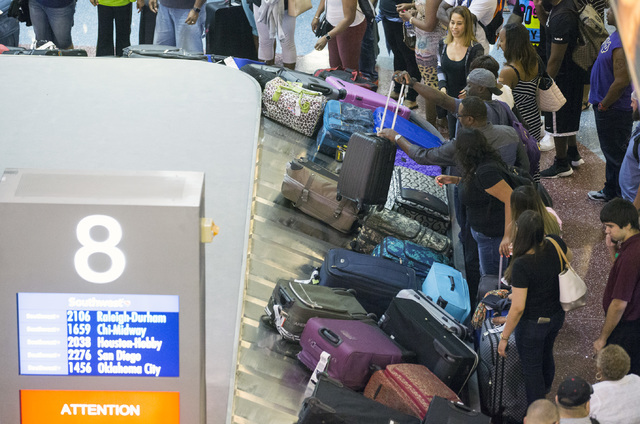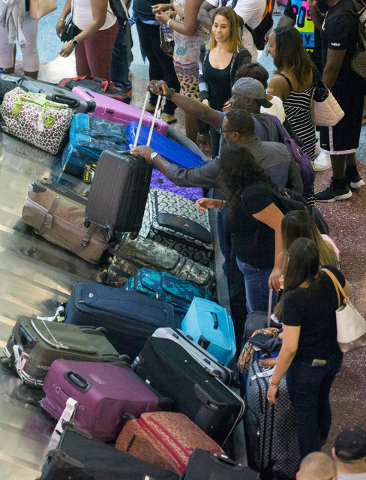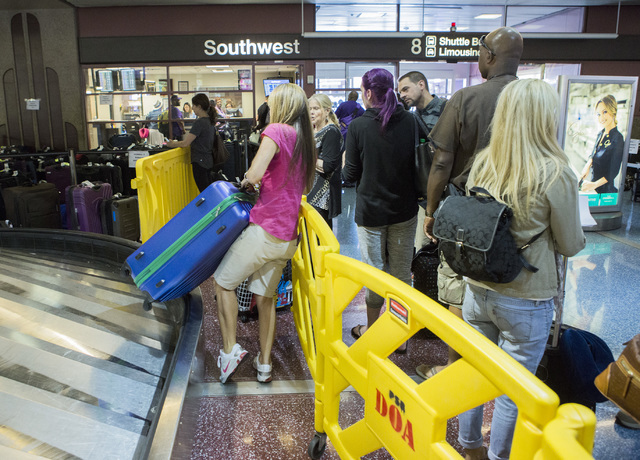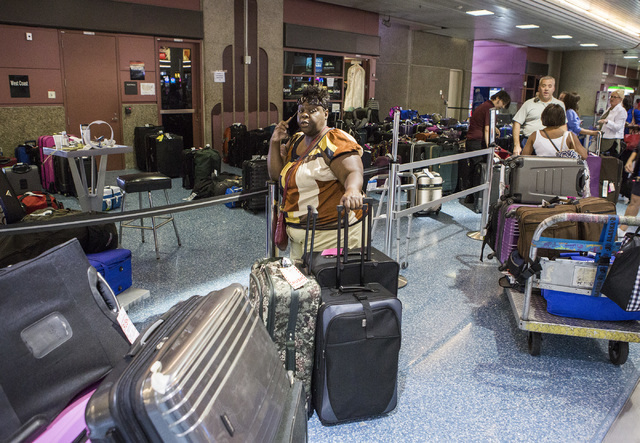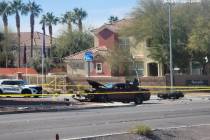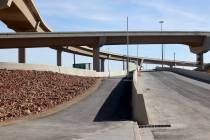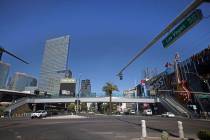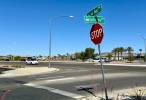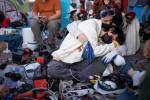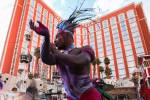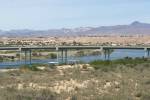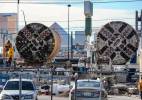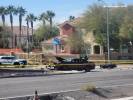McCarran airport’s baggage has a frequency all its own
Security screening became part of the traveler’s lexicon in the years following the terrorist attacks that took down four jetliners on Sept. 11, 2001.
Metal detectors immediately were installed at airports across the country to make sure passengers weren’t armed or that weapons weren’t stashed inside suitcases.
At the same time, officials who worked for airports and airlines got together to devise a method aimed at keeping track of bags that are checked at the airport and stowed in the belly of airplanes.
Before 9/11, bags were sorted into two categories at McCarran International Airport.
“They were either California bags, or they were not California bags,” said Samuel Ingalls, assistant director of aviation at McCarran. “It was just as simple as that,” Ingalls said. “That was really the extent of our tracking back in those days.”
Clearly, a better system was needed to keep an eye on suitcases leaving Las Vegas.
For decades, the tried and true method has been to print up paper tags with bar codes that could be scanned by airline workers. Those bar codes, however, have an 80 to 90 percent reliability rate because the scanners could be dirty or the paper tags could be torn and wrinkled.
By 2005, McCarran International and Hong Kong International airports started printing baggage tags that use bar codes along with radio frequency identification as a way to track suitcases accurately.
A scanner emits radio waves to capture a series of unique numbers, similar to a license plate, which are stored within the chip that correlates to the bag’s owner. The radio frequency system has a “very accurate” rate of 99.2 percent to 99.6 percent, Ingalls said.
The next time you fly out of McCarran, peel a luggage tag apart. You’ll see a tiny copper chip surrounded by a silver antenna, roughly 3 inches long. Each radio frequency-embedded tag costs 12.5 cents to print, compared with about 3 cents for tags without the technology, Ingalls said.
McCarran was a rare early adopter of radio tags because it funded all the necessary infrastructure and equipment during a makeover of the airport. Elsewhere, most airports rely on the airlines to pay for such improvements and handle their own bag-tracking systems.
For the radio tracking system to be truly effective across the entire system, airlines and airports need to embrace the technology on a wider scale, Ingalls said.
And therein lies the rub.
Some airports and air carriers are just now coming on line with radio identification systems. Earlier this year, Delta Airlines announced a $55 million plan to deploy a radio identification baggage tracking system, similar to the one at McCarran. Qantas and other carriers are testing reusable radio chips that are embedded in plastic casings.
In the meantime, at least travelers will know where their checked bags are located while waiting inside McCarran and Hong Kong International.
CACTUS EXTENSION
Like many major roads in Las Vegas, Cactus Avenue abruptly ends and restarts in the most unexpected places. Mitch from Las Vegas wanted to know whether Clark County officials plan to extend Cactus between Durango and Buffalo on the southwest end of town in Mountains Edge.
Issues remain with property acquisition and right-of-way access, county spokesman Dan Kulin said. A project that calls for linking Rainbow Boulevard between Cactus and Blue Diamond Road will wrap up in January. Also, traffic signals are being installed in your neighborhood at Buffalo Drive and Gomer Road, and also at Buffalo and Mountains Edge Parkway.
ALMOST DONE
Lane closures have become a common sight since May at North Green Valley Parkway and Sunset Road in Henderson, and Gary wanted to know what was going on.
The city and NV Energy have spent the past several months completing some utility work and refurbishing some deteriorating manholes along Sunset, Henderson city spokeswoman Kim Becker said.
The city’s portion of the construction is completed, while NV Energy is still wrapping up work on a water line.
“It is expected to be complete any day now,” Becker said.
Questions and comments should be sent to roadwarrior@reviewjournal.com. Please include your phone number. Follow the Road Warrior on Twitter @RJroadwarrior
Road work ahead
The ramp leading from westbound Warm Springs Road to the westbound 215 Beltway will be closed from 7 p.m. to 5 a.m. Sundays through Fridays until mid-March. Crews are working on the new flyover ramp and bridge.
The ramp leading from northbound U.S. Highway 95 to the westbound 215 Beltway will be closed from midnight to 5 a.m. Monday. Crews will place temporary frames for construction.
The ramp leading from southbound U.S. Highway 95 to southbound Interstate 15 will be closed from 10 p.m. Friday to 10 a.m. Sept. 18. Crews are working on Project Neon.
North Fifth and North Lawrence streets will be closed between East Ann Road and El Campo Grande in North Las Vegas beginning Monday through Oct. 1. Crews are making storm drain improvements.
Bonanza Road is restricted between 19th Street and Mojave Road through Sept. 30 as crews install gas lines.
The Martin Luther King Boulevard onramp to northbound U.S. Highway 95 is closed through November. Crews are erecting retaining walls around the Spaghetti Bowl interchange as part of Project Neon.
Third Street will be closed between Stewart and Ogden avenues from 5 p.m. Sept. 25 to 5 p.m. Oct. 3 for the Hogs and Heifers Anniversary Party and Rally in the Alley.
Decatur Boulevard will be restricted between Bonanza Road and Vegas Drive through Friday. Crews are building a new median island.
Cliff Shadows Parkway and Lone Mountain Drive are restricted at the 215 Beltway through Oct. 16. Crews are realigning the Beltway.
Summerlin Parkway is restricted between Buffalo Drive and the 215 Beltway through Oct. 1. Crews are installing a cable rail median.
Bridgeport Drive will restricted at Spokane Drive until Sept. 30 as crews work on sewer lines.
The Rancho Drive exit from southbound U.S. Highway 95 will be closed through mid-September as crews work on Project Neon.
Buffalo Drive will be restricted between Sky Pointe and Grand Teton Drive from 7 a.m. to 4 p.m. weekdays through Oct. 15 as crews improve pedestrian crossings.
Cimarron Road will be restricted between Sky Pointe and Grand Teton Drive from 7 a.m. to 4 p.m. weekdays through Oct. 15 as crews improve pedestrian crossings.
Elkhorn Road will be restricted between U.S. Highway 95 and Tenaya Way from 7 a.m. to 4 p.m. weekdays through Oct. 15 as crews work on road improvements.
Sections of Bonneville Avenue, Charleston Boulevard, Grand Central Parkway and Martin Luther King Boulevard will have closed or disrupted lanes surrounding the Spaghetti Bowl as crews work on Project Neon through July 2018.
Traffic will be redirected and reduced to one lane in each direction of U.S. Highway 95 for about a mile in Boulder City through March. Crews are building a bridge over the highway for the future Interstate 11 corridor.
Valley Drive is being widened between Tropical Parkway and Cheyenne Avenue in North Las Vegas, with completion expected in March.
Sahara Avenue is restricted between Las Vegas Boulevard and Tam Drive until Sept. 22 due to construction of the new Lucky Dragon Hotel and Casino.
Gasoline prices
The average gasoline price Friday in the Las Vegas Valley was $2.42 per gallon. It was $2.46 in Nevada. The national average of $2.18 is down 3 cents from a week ago, up 6 cents from a month ago and down 20 cents from a year ago.



